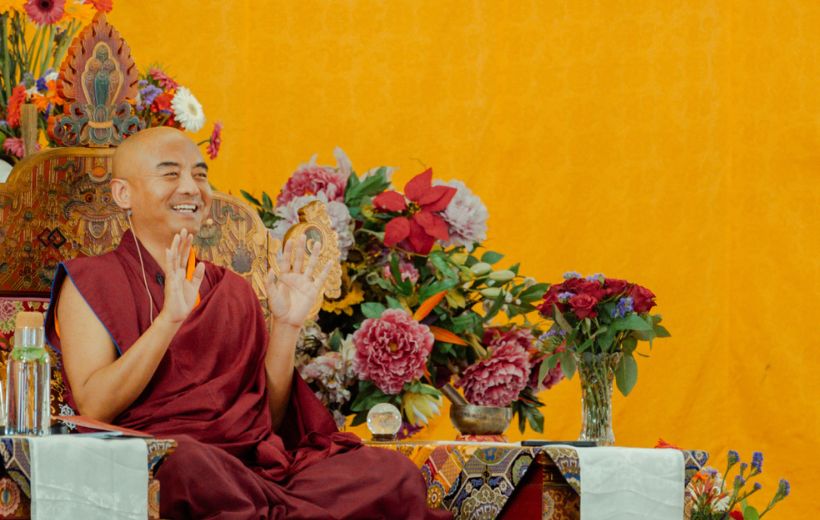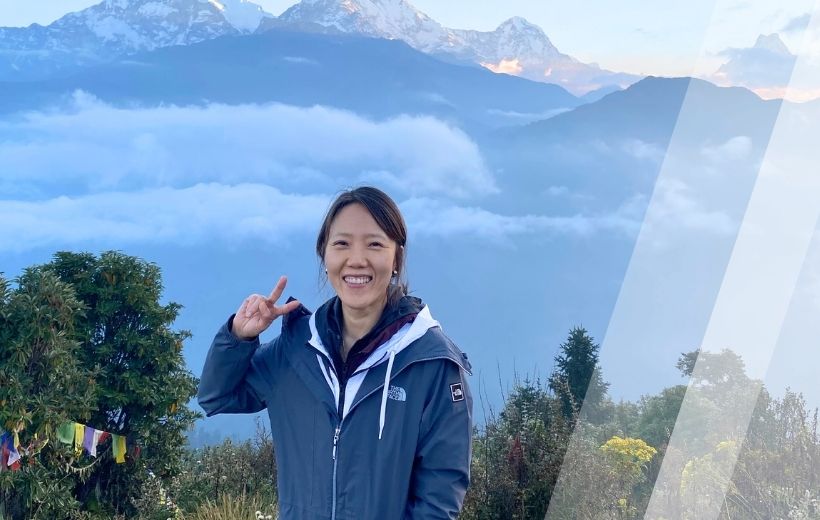Translating Tibetan Teachings at Osel Ling
By Franka Cordua-von Specht • 3 min read

Whether at Tergar International or Tergar Institute programming, the well-spoken, dynamic Joseph Faria translates for the teachers (khenpos) of Osel Ling monastery in Kathmandu, Nepal. A devoted student of Mingyur Rinpoche, he has lived in Nepal for 12 years, intensively studying the Tibetan language and completing a Master of Buddhist Studies at Rangjung Yeshe in Boudhanath, Nepal. Along with Michele Martin and Adam Kane, Joseph has translated Rinpoche’s new book Stainless Prajna.
When I was in high school in the mid-2000s, I was taking a class about different world cultures. I had a great teacher who was very enthusiastic and also interested in Buddhism and the Tibet cause. We started to learn more about India and Tibet and a little bit about Buddhism and His Holiness, the Dalai Lama.
This came at a time when I was a teenager and had started to drift away from the religion that I was brought up in. Because of the religious conflicts of the time, I wanted a religion that was more peaceful. I was especially interested in the idea of non-duality, and I was starting to notice those elements within the teachings of the Buddha.
But it wasn’t until later, when I started college and was experiencing emotional turbulence and personal problems, that I felt I needed some kind of support to deal with those problems in a way that I wasn’t quite emotionally capable of at the time. That’s when I remembered the teachings of the Buddha. I started to buy all these books and read about the teachings of His Holiness the Dalai Lama, and I started to learn more about meditation and emptiness.
I came across this book called The Joy of Living. I remember devouring it within a couple of days, and I was deeply impacted by the way Mingyur Rinpoche spoke about science, particularly meditation, being so clear, practical, and to the point.
Shortly after, I learned that Rinpoche was leading a retreat in Garrison, New York, around 2009. I remember thinking that I had to go to those teachings. When I went to the teachings in Garrison, I instantly fell in love with Rinpoche, his teaching style, and his meditation instruction, and I had this deep desire to have him be my teacher.
And yet, during that time, I was feeling somewhat anxious about my decision. I was thinking to myself, “Oh, I’m basically no one. How could I ever say that such an incredible person should be my teacher?” Then, spontaneously, without any prompt from me, Rinpoche said it isn’t the teacher who picks the student, but it’s the student who picks the teacher. Immediately upon hearing that, my anxiety and apprehension fell away, and I knew he was my teacher.
I’ve always felt this deep and special connection to Rinpoche, and I’ve always been amazed by the clarity, depth, and profundity of his teachings. They have transformed my entire life.
“I found that my practice as a translator has been pivotal in gaining more experience and knowledge of the teachings and also in helping facilitate the interaction between communities of Buddhist teachers and practitioners.”
Initially, when Rinpoche announced that he was going to do a wandering retreat — this was after I had graduated from university in the States — I decided that I should spend the time while Rinpoche was away doing something meaningful that would allow me to better serve Rinpoche and support his vision and teachings.
I thought the best way for me to do that would be to study more about Buddhism and the Tibetan language in the hopes of eventually becoming a translator. In 2012, I arrived in Nepal and started to study at Rangjung Yeshe Institute in Boudha.
I spent a few years pursuing my master’s degree in Buddhist studies there while intensively studying the Tibetan language on the side. I became very interested in the Tibetan language and how the dharma is conveyed and expressed through it. I had a strong passion and interest in studying Tibetan, and within a few years, I started to translate here and there for various lamas and teachers. I was finding some success in that.
I even started to teach the Tibetan language to various students from all over the world at Rangjung Yeshe Institute. Eventually, when Rinpoche returned from his wandering retreat, I started to talk with him more and more. He expressed his interest in having me come to the monastery at Osel Ling and work on various projects. This, of course, would involve me translating for our khenpos when they give teachings. I’ve had an amazing experience working with our khenpos, whether in person or online, and it’s been wonderful to see how well they convey these deep, profound, and often complex teachings in Buddhism to a diverse audience from all over the world.
Being a small part of that has been an incredible experience for me. It has allowed me to improve my own translation skills, knowledge, and connection to the dharma. I found that my practice as a translator has been pivotal in gaining more experience and knowledge of the teachings and also in helping facilitate the interaction between communities of Buddhist teachers and practitioners.
For all intents and purposes, I am living full-time here in Nepal. I am deeply in love with the country, its people, the community, and the circumstances I have at Tergar Osel Ling. I have access to this incredible place 24/7, and I love being so embedded within the monastic community here. Honestly, every time I interact with the monks and khenpos, they treat me like one of their own brothers. There’s no sense of me being an outsider or foreigner; they show me love and care just as they would for any of their own.
I feel a strong sense of belonging here and a deep connection to Rinpoche and his teachings. I am driven by a profound desire to support these teachings and the monastic community as much as possible. That’s why I want to be around them as much as possible and do whatever I can to support the amazing work happening here.
Franka Cordua-von Specht, co-founder of the Tergar Vancouver Practice Group and Tergar Canada, works for Tergar International’s marketing and communication team. She is a Tergar Guide and facilitates Joy of Living workshops.
Learn the principles and practices of Vajrayana Buddhism in this online course offered by Tergar.
Our Vajrayana Buddhism online course is for those seeking an authentic introduction to the principles and practices of Vajrayana Buddhism. It is led by Mingyur Rinpoche and includes videos, audio files, a course workbook, webinars, and a forum. This course is part of the Vajrayana Online subscription-based offering.


If you find that your emotions are challenging, join us on a transformative meditative journey as Justin Kelley reflects on Mingyur Rinpoche’s November retreat, “Abandoning, Transforming, Recognizing,” and the power of meeting the teachings where they come alive — at Tergar Osel Ling Monastery in Kathmandu.

After years of burnout and cynicism as a clinical psychologist, Hana Ko found renewed faith in humanity through the teachings of Mingyur Rinpoche.

“From raising kids to caring for aging parents, Amy Roth invites us into the heart of middle age — where the dharma meets daily life in all its complexity, humor, and unexpected beauty.”
If you enjoyed reading our articles, please join our mailing list and we’ll send you our news and latest pieces.